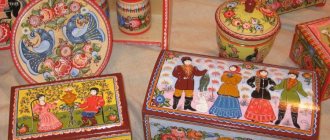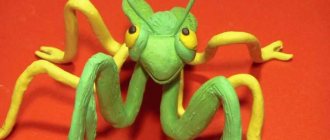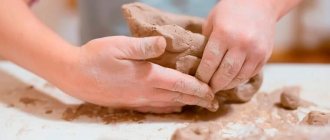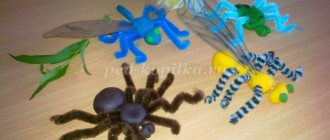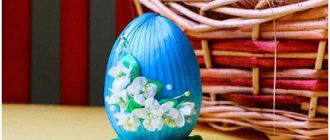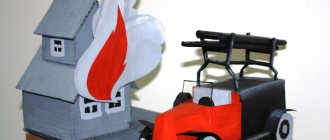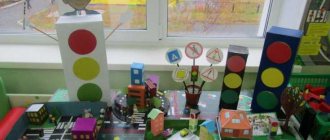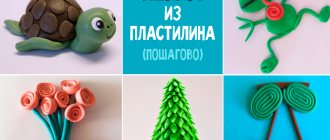Modeling from plasticine in elementary school: the benefits and goals of creative activities
When working with plasticine, fine manual motor skills develop.
During this process, children also improve and develop:
- logical thinking;
- memory;
- motor coordination;
- speech;
- perseverance and patience;
- Creative skills;
- abstract and figurative understanding;
- imagination;
- attentiveness;
- emotional condition;
- self-esteem;
- hand-eye coordination;
- manual touch;
- observation and eye.
The tasks of modeling from plasticine are:
- formation of ideas about shapes and colors;
- safety training with material during classes;
- stimulation of fantasy and imagination;
- distraction from irritating and harmful factors;
- learning to cope with one’s own anxieties and fears;
- improving the condition of the nervous system and the body as a whole;
- nurturing self-confidence;
- developing interest in creativity;
- formation of aesthetic taste;
- training in the three-dimensional method of depicting objects.
Research project “Study of the properties of plasticine”
Relevance of the work:Plasticine is a material familiar to everyone from early childhood. We use plasticine in technology lessons. It is bright, soft, elastic, and most importantly, you can create absolutely anything from it: your own colorful world, full of adventures and unusual creatures. We already know how to sculpt all kinds of figures: dolls, animals. We would like to know more about the quality and properties of plasticine, whether it is possible to make plasticine at home. What properties will the manufactured plasticine have? We decided to make plasticine at home and compare its properties with industrial plasticine.
Hypothesis: Let's assume that the properties of plasticine obtained at home coincide with the properties of production samples.
Purpose: Check the properties of plasticine from different manufacturers.
Tasks:
-study the qualitative composition of plasticine;
-show the use of plasticine;
-make plasticine at home;
-conduct a study of samples;
-analyze the result. Object of study: samples of plasticine from different manufacturers.
Subject of research: properties of plasticine. Research methods: work with sources of information, experiment, observation. 1.From the history of plasticine
The word plasticine
originates from the Italian word
plastilina,
and from the Greek
plastós,
which means stucco.
200 years ago no one knew about this wonderful substance. And its invention can be attributed to two people at once - pharmacist Franz Kolb and inventor William Harbutt. The first of them in 1880 patented a model mass called “Plastilin”, and the second in 1897 invented non-drying clay, giving it the name “Plasticine”. The inventions were almost identical, and were collectively called plasticine. William Harbutt tried for a long time to find an application for his invention in the field of modeling. One day he discovered that his six children were as interested in the invention as he was. Therefore, William decided to fill the house with various plasticine products - castles, fountains and ships. At first, the substance had only one color - gray. But after a few years, plasticine in four colors went on sale. Seeing how quickly the products were sold out, Harbutt decided to open his own factory. Gradually the invention gained enormous popularity. Smart plasticine has become a favorite hand toy for adults and children. But the usual, classic look is also used by many artists, architects and engineers to create various models, ranging from a spaceship to dinosaur figures.
2. Types of plasticine
Today, the children's goods market offers a wide range of different types of plasticine:
- Plasticine
is successfully used in children's creativity.
Soft, plastic, painted in bright colors. Due to the wax introduced into its composition, this plasticine is easily kneaded even in weak hands, and the parts of the figures are perfectly attached to each other. Foreign manufacturers produce plant-based plasticine
and are considered the most popular. Pieces of different colors are easily mixed with each other to obtain new shades, and the fluorescent colors of such plasticine delight everyone. - plasticine
_ After some time in the air it hardens, and you can play with crafts made from such plasticine along with other toys. There are several types of hardening plasticine. - plasticine
, as its name implies, consists of small foam balls bound together by a glycerin-based substance.
You can make voluminous crafts and panels from such plasticine. Homogeneous hardening plasticine is more pleasant to work with; it helps to realize the most complex ideas. Floating plasticine
does not have any special advantages compared to other types. Except for one thing: crafts can float. From such plasticine you can fashion a toy for an evening swim, send a flotilla of boats on a voyage, or launch a flock of swans in a basin of water.
3.
Composition of plasticine
Plasticine is the same clay that people have been familiar with for several millennia. Modern plasticine masses are made on the basis of many different components, the quantity of which ultimately determines the characteristics of the material for modeling: appearance, harmlessness, softness. It is worth noting that the plasticine sold today by most manufacturers is very different in composition from that which was present on store shelves 15-20 years ago.
If earlier for the production of plasticine they used mainly animal fat, supplemented with various chemical components, today there are many types of children's plasticine, significantly different from each other in composition.
In addition to fine purified clay powder, the composition of modern plasticine also includes dyes, wax, animal fat, petroleum jelly and other substances that prevent the plasticine from drying out and hardening. It is these substances that give plasticine softness, plasticity and stickiness. Wax promotes softening when heated and hardening when cooled. Ceresin helps plasticine retain its shape, and fat makes it waterproof. Plasticine always contains a dye that gives it the desired color. Otherwise, all the plasticine would have a clayey-grayish tint.
The most common components of modern plasticine are:
- fine clay powder;
- beeswax;
- animal fat;
- ceresin is a mineral wax, which, among other things, is used in the production of cosmetics as a binder and softening additive;
- pigments (color dyes);
- Vaseline, which prevents the plasticine mass from drying out quickly, making it soft and pliable.
4. Making plasticine at home
From materials on the Internet, we learned that plasticine can be made at home.
Several manufacturing technologies have been found, using heating and cold methods. We decided to make plasticine using a safe, cold method. We have determined the basis of plasticine, which can be prepared at home. The base is: flour, salt, water, vegetable oil Recipe
Starch - 1 tablespoon
Water - 1 glass
Salt - half a glass
Vegetable oil – 2 tablespoons
Flour – 2 cups
Glycerin – 5-10 drops (a substance that prevents hardening and drying out)
Stages of work:
1.Pour water into the container.
2. Add salt. 3. While stirring, dissolve the salt in the water.
4.Add vegetable oil. 5.Add glycerin.
6.Pour in flour. 7. Mix everything thoroughly. 9. Divide into parts. eleven . Add dye (gouache) to each part. 13. Knead until the color is uniform. 14. Place the finished plasticine in storage containers. Conclusion:
You can make plasticine at home.
5. Study of the properties of plasticine
We decided to compare and test the manufactured plasticine for properties such as softness, plasticity, soilability, and, of course, the ability to glue parts. For the study, we took several types of plasticine from different manufacturers Poland, No. 2 – “Plasticine Classic”, manufactured by LLC PA “Raduga”, Ryazan, No. 3 – “Plasticine Cartoons”, manufactured by JSC “Gamma”, Moscow, No. 4 – “Bioplasticine with AloeVera" manufactured by Premier - Plast LLC, Yoshkar - Ola, No. 5 - manufactured plasticine.
1 experience. Testing plasticine for softness
.
Progress:
- Cut off a small slice.
- They held it in their hand.
- The results obtained were recorded in Table 1.
Table 1. Testing plasticine for softness.
№1
| №2 | №3 | №4 | №5 | |
| soft | soft | solid | solid | soft |
Conclusion:
Plasticine No. 1,2,5 is soft, No. 3,4 is hard, but under the influence of heat it becomes soft.
2 experience. Study of plasticine for plasticity
.
Progress:
- Cut off a small slice.
- They held it in their hand.
- We ran a piece of plasticine across a sheet of paper
The results obtained were recorded in Table 2.
Table 2 . Study of plasticine for plasticity
| №1 | №2 | №3 | №4 | №5 |
| crumbles | plastic | plastic | plastic | plastic |
Conclusion:
All types of plasticine, except plasticine No. 1, have plasticity.
3 experience. Study of plasticine for the ability to bond parts
.
Progress:
- Cut off a small slice.
- We made a craft.
- The results obtained were recorded in Table 4.
Table 4. Study of plasticine for the ability of gluing parts.
| №1 | №2 | №3 | №4 | №5 |
| Badly | Badly | Fine | Fine | Fine |
Conclusion:
Plasticine No. 1 and No. 2 have weak gluing ability; we do not recommend using such plasticine in the manufacture of crafts. Plasticine No. 3,4,5 has good gluing ability. This plasticine can be used to make crafts.
Conclusion
Thus, in the course of the work done, we studied the composition and properties of types of plasticine, obtained plasticine at home and conducted a comparative analysis of industrial and home samples of plasticine.
As a result, the following conclusions can be drawn:
- plasticine can be obtained at home;
- a homemade sample of plasticine has all the characteristic properties of plasticine;
- The research hypothesis was confirmed - the properties of plasticine obtained at home coincide with the properties of production samples.
Types of beautiful and safe plasticine for children
The table will introduce safe and non-toxic types of plasticine for children:
| Plasticine type | Features of the material |
| Classical | It can be soft or harsh; quite soiled, difficult to wash. |
| Wax | Very soft and sticks well. |
| Ball | In the form of weightless granules, which are connected by harmless glue; can glow in the dark and adheres perfectly to paper. |
| Solidifying | It dries within a day and is suitable for creating entire collections of crafts, for example, Christmas tree decorations. |
| Art plasticine | The hard one is intended for three-dimensional crafts, and the soft one is for plasticineography and appliqués. |
| Floating | Non-fading crafts made from it can float. |
Modeling as a hobby. Alternative materials for modeling.
In addition to ordinary plasticine, you can also find other materials for modeling on sale that will diversify your child’s leisure time and captivate him with creative work.
Modeling masses
With the help of modeling mass, a child will be able to create toys with his own hands, because, unlike plasticine, modeling mass hardens in air. The properties of the modeling compound are similar to plasticine; it is very plastic and wrinkles easily. It is convenient and pleasant to work with, and the polymer that underlies it is safe for a child, even if he accidentally swallows a piece. Modeling compound is sold either by color or in modeling kits. It offers interesting kits for sculpting figures - they include a lot of different colors and instructions, according to which the child can make a beautiful toy himself.
| Mass for sculpting Kalyak-Malyak, set “Funny Animals” | Mass for sculpting Kalyak-Malyak figures, set “Kitten” | Mass for sculpting Kalyak-Malyak figures, set “Penguin” |
Play dough
The play dough you find in stores is made from natural ingredients, unlike play dough. It is based on salted dough with added dyes. Just like the modeling mass, the dough hardens in air, and then you can also make various toys from it. But after drying, the dough may crack and the toy will no longer be so attractive. Therefore, the dough is better suited as a plasticine substitute for frequent use. Modern play dough kits often include various tools and molds that make it easy to create original and interesting crafts. Due to its natural nature, the modeling dough is suitable for activities with the youngest children.
Sand for modeling
Quartz, or kinetic, sand appeared on the market relatively recently, but has already won the love of parents. In terms of its properties, it is still closer in wet sand than in plasticine, i.e. It will not be possible to create complex figures and elements from it. But this is not necessary - after all, with the help of such sand you can create a real sandbox at home! It is easy to sculpt and holds its shape well - you can create entire sculptures using different molds or with your own hands. A home sandbox is a fun game that will keep your child occupied for a long time all year round and in any weather. At the same time, “homemade” sand does not get dirty, does not crumble and does not stick to clothes and furniture, which cannot but please parents. Quartz sand sets are recommended for very young children.
| Modeling dough “Plastishka” 7 colors | Modeling kit “Home sandbox” |
Tips for creating plasticine applications
There are no generally accepted standards for making applications from plasticine. While developing a creative idea, you can turn on your imagination to the fullest. Various techniques can be easily combined with each other. For example, an outline of flagella can be filled with smudges or beads.
You can choose any picture as an idea for an application. It can be used as a template. Ready-made templates for applications can be found on the Internet. To work, you will need to download and print them.
If you get your child interested in creating plasticine applications, he will spend time usefully, developing his creative abilities and fine motor skills.
